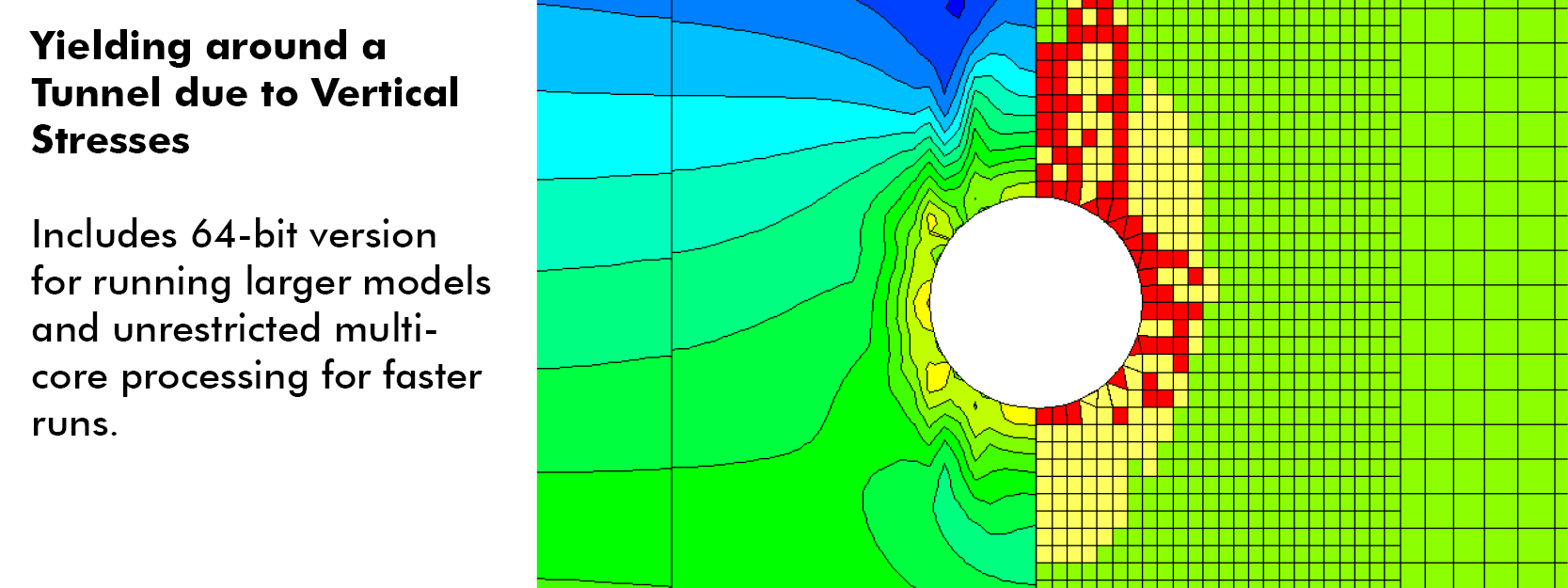

At the end of this post, there are links to GTC Digital sessions that offer deeper dives into the new CUDA features.
#Flac3d forum full#
Full support on all major CPU architectures, across x86_64, Arm64 server and POWER architectures.Ī single post cannot do justice to every feature available in CUDA 11.Updates to the Nsight product family of tools for tracing, profiling, and debugging of CUDA applications.Performance optimizations in CUDA libraries for linear algebra, FFTs, and matrix multiplication.Programming and APIs for task graphs, asynchronous data movement, fine-grained synchronization, and L2 cache residency control.New third-generation Tensor Cores to accelerate mixed-precision, matrix operations on different data types, including TF32 and Bfloat16.Multi-Instance GPU (MIG) partitioning capability that is particularly beneficial to cloud service providers (CSPs) for improved GPU utilization.Support for the NVIDIA Ampere GPU architecture, including the new NVIDIA A100 GPU for accelerated scale-up and scale-out of AI and HPC data centers multi-GPU systems with the NVSwitch fabric such as the DGX A100 and HGX A100.
#Flac3d forum software#
This post offers an overview of the major software features in this release:

The A100 GPU has revolutionary hardware capabilities and we’re excited to announce CUDA 11 in conjunction with A100.ĬUDA 11 enables you to leverage the new hardware capabilities to accelerate HPC, genomics, 5G, rendering, deep learning, data analytics, data science, robotics, and many more diverse workloads.ĬUDA 11 is packed full of features-from platform system software to everything that you need to get started and develop GPU-accelerated applications. solving solve dytime=eq_time -history reading set hisfile test1.his his write 105 vs 108 skip 100 -earthquake loading FISH program def eqset_1 eq_time=39.88 pgmulti=1.0 c_s1=(shear_a/dens_a)^0.5 multi_sxy1=-0.01*(dens_a)*(c_s1)*pgmulti end eqset_1 -compliant base hist 1000 read M7_Loma_Prieta.The new NVIDIA A100 GPU based on the NVIDIA Ampere GPU architecture delivers the greatest generational leap in accelerated computing. 005 set dyn damp local = pi * 0.05 -dynamic analysis setting set corr_ffrot on base rotation prevention app ff set dytime 0.0 set large set multi on set step 005ģ4 Outline Earthquake modeling using fully dynamic analysisĬonfig dyn -static analysis set dyn off -dynamic analysis set dyn on ini xdisp 0 ydisp 0 xvel 0 yvel 0 -history monitoring hist reset his sxx i 71 j 35 his xdisp i 72 j 34 his xvel i 72 j 34 his xacc i 43 j 2 his dytime -damping set dy_damp rayl stiffness initial damp hyst hardin. Hardin/Drnevich model – hardin initial damp hyst hardin. Seismic coefficients for pseudostatic slope analysis, Cristiano Melo and Sunil Sharmaģ0 Local Damping set dyn damp local = pi * 0.05ģ1 Rayleigh Damping set dy_damp rayl zmin fmin stiffness mass Seismic considerations Practical example: Seismic analysis of the cantilever retaining wallġ8 Outline Earthquake modeling using fully dynamic analysis sel liner range cyl end1 (0 0 0) end2 (0 2 0) rad 2 sel liner sel liner propġ6 Outline Introduction to the short courseġ7 Outline Earthquake modeling using fully dynamic analysis Prop bulk 5e9 shear 1e9 coh 4e4 fric 30 ini dens fix y range y fix y range y fix x range x fix x range x fix z range z set grav 0,0,-10 hist add unbal hist add gp xdisp 0,0,11 save tunnel.savġ4 Create the Support Create the support (linerSELs). Gen zone reflect dd 0 dip 90 origin check origin gen zone reflect dd 90 dip 90 dip: angle with xy plane dd: angle with xz plan origin x0,y0,z0 New gen zone radcyl group ub & p p p p p p & p p p p p p & size fill group ubhole ratio Introduction to computational geotechnics Commercial geotechnical programs Theoretical considerations Numerical modeling in FLAC and FLAC3D Practical application: Shallow foundations Practical application: Retaining wall systems Practical application: Tunnel modeling Earthquake modeling using fully dynamic analysis Louis University Los Angeles, CA January 2019Ģ Outline Introduction to the short course Geotechnical Engineer, Marino Engineering Associates, Inc. 1 INTRODUCTION TO NUMERICAL MODELING IN GEOTECHNICAL ENGINEERING WITH EMPHASIS ON FLAC MODELINGīy Siavash Zamiran, Ph.D., P.E.


 0 kommentar(er)
0 kommentar(er)
